3 Strategies to Combat the Great Resignation in 2024
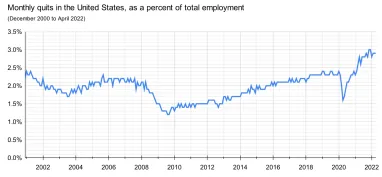
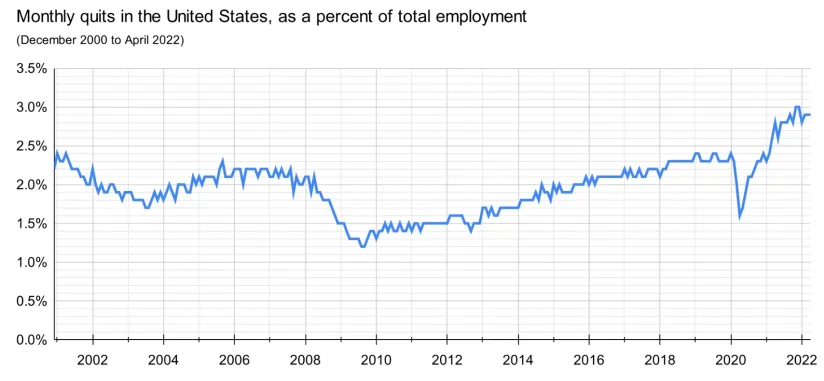
The Great Resignation is a current phenomenon where employees are willingly leaving their positions at a historically high rate.
According to Deloitte, 75% of CEOs see excessive turnover as the single biggest short-term threat to their companies since it is difficult to acquire and keep highly skilled workers. Worsely, a PwC survey found that almost 20% of workers want to change jobs between May 2022 and May 2023, suggesting that the great resignation is here to stay— at least for the foreseeable future.
In our research, moreover, we found that both white collar and blue collar workers are dissatisfied. The purpose of this article, therefore, is to provide CEOs and executives with 3 strategies to minimize the disruptive effects of high levels of resignations through:
- Augmenting the workforce with automation
- Improving ESG practices,
- And embracing remote work frameworks.
1. Augment your workforce with automation
Since the labor market is shrinking, one of the things businesses can do to protect their efficiency is increasing per worker productivity. Companies must use automation as a leverage for increasing labor productivity by allowing workers to focus on strategic and creative tasks, rather than dealing with repetitive tasks.
The Harvard Business Review’s research supports the idea of augmenting the labor force with automation since research shows labor shortage has persisted for a while: Through the 2010s we experienced a rise in the percentage of employees quitting their job voluntarily (See Figure 2).
What has changed now; however, is that quitting jobs has been accelerated after the COVID-19 pandemic because:
- Remote/hybrid jobs are available and many people want to switch to more flexible jobs.
- Many people switched jobs or retired due to COVID-induced health reasons.
- Pandemic pushed people to reconsider their ideal work-life balance model, resulting in either switching jobs or retirement.
Figure 2: Share of employees who are willingly quitting their jobs:
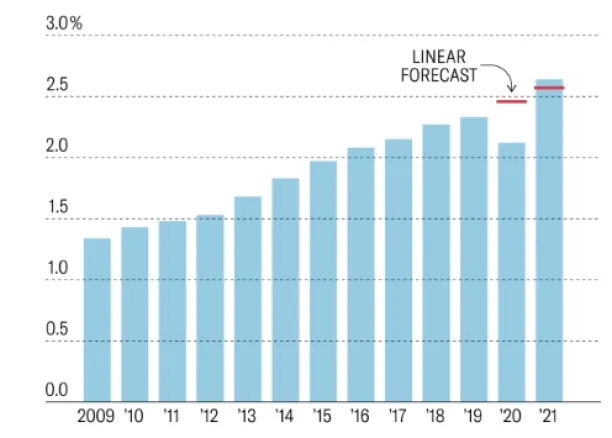
Recommendations:
Thus, to cope with this long lasting labor shortage crisis companies must adopt technologies such as:
- RPA bots are programmed to automate workers’ repetitive tasks, such as drafting emails, accessing company databases, issuing invoices, and more by mimicking humans.
- Intelligent automation is the emerging area of RPA. Intelligent automation refers to the integration of AI/ML models with RPA bots to automate more technical tasks. Consider insurance claims processing– to classify cases and enter the extracting data into claims database, an RPA should both understand the meaning of the documents (which is impossible without AI) and process the claims. When RPA is supported by plugins capable of machine learning it can automate such complex tasks.
- Digital worker is an interactive intelligent automation solution. Employees can communicate with digital workers through messaging applications (powered by conversational AI) and ask them to complete variety of tasks such as:
- Writing emails
- Organizing meetings
- Monitoring business process changes and notifying employees accordingly
- Interpreting data for employees
- Generating reports.
- Generating documents like offers and more
If you need more information regarding digital workers benefits you can read our Top 7 Benefits of Digital Workers: Enhance Your Competitiveness article.
To learn how your company may maximize the value of its digital workers, you can read our Top 7 Digital Workers Best Practices & Deployment Tips article.
2. Improve your ESG practices
People claim to believe that businesses are not doing enough to address societal problems like climate change, income gap, discrimination, and worker reskilling (See Figure 3). If employees believe that their firms are not concerned with the welfare of society, this can lead to employee disengagement. Thus, companies should focus on improving their ESG (environmental, social, and governance) posture and its reporting to assure the public and their employees about their responsiveness for societal issues.
Figure 3: People consider firms can do more for societal issues:
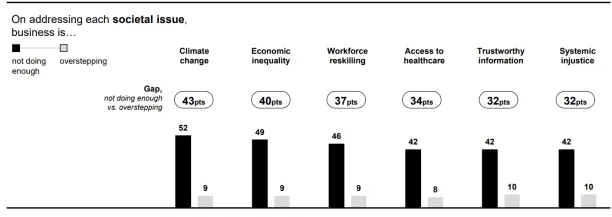
According to a study by Marsh McLennan, a consulting firm, one benefit of improved ESG performance is raising employee satisfaction around 15% and improving the company’s appeal to recent graduates by 25%. Marsh McLennan predicts that the importance of sustainable management will increase since the Gen Z population, which is more concerned with ESG issues, will make up around 70% of the workforce in 2030.
Recommendations:
You can increase your ESG posture by:
- Periodically releasing transparent ESG reports.
- Reducing the disparity in CEO pay. One-third of employees, according to PwC, want a pay increase.
- Reducing gender pay gap and any discriminative action against women since they tend to resign more often.
- Provide your workers’ benefits and training programs since fulfillment of job is as important as salary of your employees.
- Calculating and Reducing your carbon footprint.
- Measuring and labeling your products’ carbon footprint.
- Measuring your business circularity and making your business more circular via recycling, reusing and industrial symbiosis.
- Collaborating with ESG sensitive suppliers and business partners.
If you want to learn more regarding how you can improve your ESG posture you can read our following articles:
- Top 6 ESG Reporting Best Practices
- Top 6 Circular Economy Best Practices for Businesses
- Top 10 Sustainability Case Studies and Success Stories
3. Be flexible about place of work
Due to pandemic constraints, the majority of businesses move from onsite to remote employment. Many employees now indicate a preference for remote/hybrid work over on-site work after having experienced it. For instance, more than 80% of people, according to Accenture, prefer a hybrid working arrangement in which they spend four days in the office and one day working remotely. Furthermore, according to a study by Harvard Business Review, if remote or hybrid working options are not available, more than 35% of employees will look for new employment prospects.
Recommendations:
In such an environment, it is not wise to be stubborn over on-site working especially when we consider the following facts:
- According to PwC, remote/hybrid working boosted almost 60% of companies’ worker productivity in 2021.
- Hybrid/remote working reducing office costs and rents.
- Hybrid/remote work is an effective way of reducing the carbon footprint of companies (See Figure 4).
Figure 4: Carbon emissions subject to medium of travel
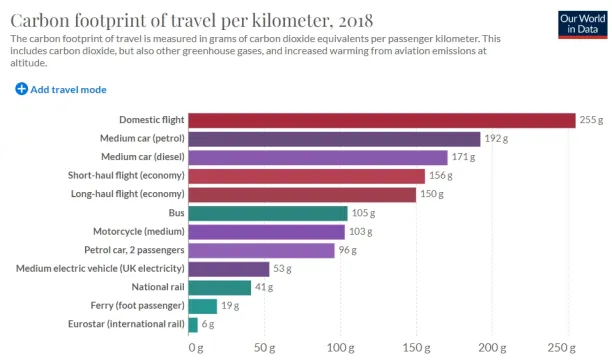
Since employees use their own devices and may connect to unsafe public WiFi, cybersecurity risks could be the only structural drawback to remote or hybrid working. However, cloud cybersecurity solutions with a zero trust architecture mentality defend enterprises from cyberattacks regardless of whether personnel are located in offices or remote locations. Therefore, we advise companies to implement cybersecurity tools like:
- Secure access service edge: The unified network and security solution for enterprises. SD-WAN, carriers, content distribution networks, and edge devices are elements of SASE’s network as a service. Zero trust network access, secure web gateway, and firewall as a service are all parts of security as a service.
- Zero trust network access: is the security solution that continuously validates individuals and devices to grant access.
- Secure web gateway: Allows URL filtering to protect organizations against web related threats.
- Firewall as a service: Supervises network traffic according to security protocols that have been set.
If you need more information regarding how you can further improve your cybersecurity posture you can read our following articles:
- Top 8 Cybersecurity Best Practices for Corporations
- Top 4 Secure Web Login Best Practices for Corporations
If you have further questions regarding great resignations and the ways of combating with it you can reach us:
Source: Image 1

Cem has been the principal analyst at AIMultiple since 2017. AIMultiple informs hundreds of thousands of businesses (as per similarWeb) including 60% of Fortune 500 every month.
Cem's work has been cited by leading global publications including Business Insider, Forbes, Washington Post, global firms like Deloitte, HPE, NGOs like World Economic Forum and supranational organizations like European Commission. You can see more reputable companies and media that referenced AIMultiple.
Throughout his career, Cem served as a tech consultant, tech buyer and tech entrepreneur. He advised businesses on their enterprise software, automation, cloud, AI / ML and other technology related decisions at McKinsey & Company and Altman Solon for more than a decade. He also published a McKinsey report on digitalization.
He led technology strategy and procurement of a telco while reporting to the CEO. He has also led commercial growth of deep tech company Hypatos that reached a 7 digit annual recurring revenue and a 9 digit valuation from 0 within 2 years. Cem's work in Hypatos was covered by leading technology publications like TechCrunch and Business Insider.
Cem regularly speaks at international technology conferences. He graduated from Bogazici University as a computer engineer and holds an MBA from Columbia Business School.
To stay up-to-date on B2B tech & accelerate your enterprise:
Follow on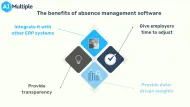
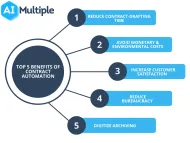
Comments
Your email address will not be published. All fields are required.